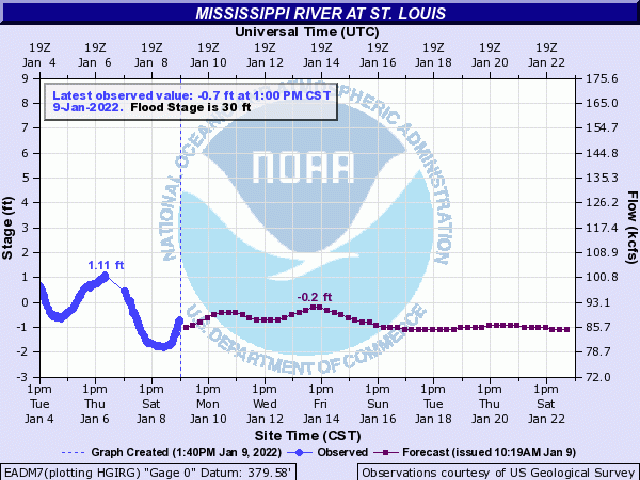Cash Market Moves
Misery for Shippers on Mississippi, Illinois, Ohio Rivers
While the far Upper Mississippi River hibernates for the winter, things are not looking good at St. Louis, where water levels are below zero gauge. In fact, the Upper Mississippi and Illinois Rivers remain low, while the Ohio River is forecast to move above minor flood stage Jan. 10.
"St. Louis Harbor water levels remain low and are expected to continue a slow fall," said Tom Russell of Russell Marine Group. "Barge drafts will
likely be reduced from 10.5 feet to 9.5 feet the week of Jan. 10. Water levels have creeped into negative territory. Tow operations will continue to operate, but may require barge draft reductions, tow size reductions and dredging in the Harbor area to maintain traffic flow."
Russell added, "The amount of rain for central Midwest may be below normal. Rain and water levels in St Louis area will require close monitoring during coming weeks." (See https://water.weather.gov/…)
On the Ohio River, Russell said, "The current rise will be a rather fast rise and fall; however, January-through-March precipitation forecasts above average precipitation for Ohio River Valley, indicating water levels could remain on the high side. Tows are moving and expected to continue to operate with some safety protocols." The level on the Ohio River at Cairo the afternoon of Jan. 9 was at 39.19 feet and heading to minor flood stage of 40 feet.(See https://water.weather.gov/…)
P[L1] D[0x0] M[300x250] OOP[F] ADUNIT[] T[]
Illinois River water levels remain low and the "recent very cold snap has caused some ice to develop in areas on the Illinois River. Tows and barges are moving at slower speeds," said Russell.
American Commercial Barge Line reported as of Jan. 7, "All locks on the Illinois River are requiring ice couplings and most locks have 100% ice coverage. ACBL has implemented tow side reduction on all boats on the Illinois River and boats heading to Illinois River due to the ice conditions. Single-digit temps next couple of days and freezing temps next seven days will create ice quickly. Lower end of the Illinois River around Lagrange lock has seen the most impact of the ice conditions; as of this morning there are 22 boats waiting lock turn."
The USACE noted, "Ice couplings are a different way of attaching barges to one another that allows them to re-attach even with ice buildup on the outside of the wet barges."
Lower Mississippi River (LMR) levels have been low, but the recent rains in the Ohio River Valley provided a much-needed rise. "As water off the Ohio River flushes down the LMR, the LMR will experience a rise from Cairo to New Orleans during January. However, water levels are not currently expected to reach flood levels or levels that will require implementation of safety protocols on the LMR," said Russell.
Russell said at the Baton Rouge and New Orleans Harbors, dry forecasts will help loading operations. "However, it is fog season. Fog closures in the Port are forecast to increase to above normal in January and February due to warmer air and onshore winds from the Gulf."
As I have noted more than once in the DTN Daily Basis comments, in recent weeks the fog has been responsible for delays in unloading/loading at the Gulf and, in turn, has slowed empty barges getting back upriver to waiting shippers.
In addition to the above issues, "All grain facilities hit by Ida, the Aug. 29, 2021, Category 4 hurricane, are still playing post hurricane 'catch up' and working to get ahead of the backlog of vessel loadings and that 'catch up' will drag into first half February," said Russell.
All these river issues have been causing logistics problems for exporters and, on top of that, barge freight has been rising. When barge drafts are reduced, shippers still are paying the same for a fully loaded barge. In addition, exporters waiting for rail to load out and ship downriver are seeing higher freight costs and railroad slowdowns due to staff shortages and poor weather. BNSF secondary shuttle freight Jan. 7 was bid $2,000 per car over tariff against offers of $3,300, while February bids are $1,200 over against offers of $2,000. In response, January CIF NOLA soybean and corn basis is inverted to February basis, while basis for rail delivered into St. Louis has been stronger during the first week of January.
Even though exports have been slow for the current timeframe, shippers still need to load out commitments and the current logistics messes on the river and interior have hampered their ability to do so, along with slow cash movement to boot.
Mary Kennedy can be reached at mary.kennedy@dtn.com
(c) Copyright 2022 DTN, LLC. All rights reserved.



